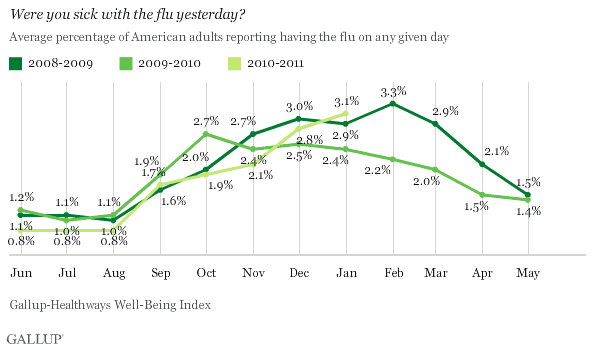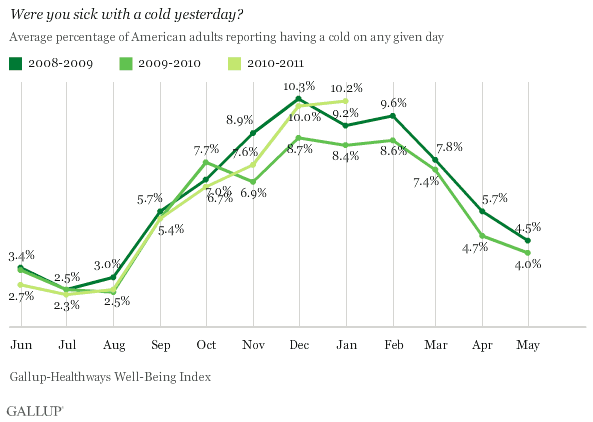WASHINGTON, D.C. -- After a slow start to the season, Americans' self-reports of colds and the flu are on the rise, tracking higher now compared with the last two years, according to the Gallup-Healthways Well-Being Index. In January, 3.1% of Americans reported having the flu the day before the survey, compared with 2.4% last season and 2.9% in 2008-2009.

The asks 1,000 Americans each day whether they had a cold and the flu "yesterday." In general, the percentage of Americans who report having had a cold on any given day is roughly three times greater than the percentage who report they had the flu.
The measurement of colds vs. the flu in a survey research environment is complex because of the overlapping symptoms of the two disease conditions and many Americans' misunderstanding of which symptoms constitute "the flu" versus "a cold." It is also possible that the estimate of daily cold and flu prevalence is underestimated, as would-be respondents who were sick the day before may be less likely to respond to a phone survey than those who were not sick. Still, Gallup's measurement approach -- asking the same question in the same survey day after day -- does provide evidence as to whether the incidence of these conditions is increasing or decreasing from month to month and year to year.
January Reports of Colds Surpass 2009, 2010 Levels
In each of the past two years, reports of daily colds were highest in December, followed by somewhat lower levels in January and February -- typically the three peak months of cold and flu season. This season, however, more Americans reported colds in January (10.2%) than did so in December (10.0%). The 10.2% of Americans reporting a cold the prior day is the second highest level recorded across the past three cold and flu seasons, just shy of the 10.3% measured in December 2008.

Americans' increased reports of daily cold and flu in January were not uniform across the United States. Those living in the East experienced the greatest increases for both conditions since November, with a 3.1-percentage-point increase in reported colds and a 1.8-point increase in reported flu cases. This could reflect the particularly bad winter weather in the East this year, which may have kept more people indoors, giving colds and flu viruses better opportunity to spread.
Bottom Line
After tracking at below-average levels in September, October, and November, Americans' average daily reports of colds and the flu sharply increased in December and January, now surpassing levels found in the same month in previous years.
The Centers for Disease Control and Prevention, which tracks clinically confirmed influenza via collaborating laboratories in all 50 states and the District of Columbia, has reported similar trends, with the second and third weeks in January representing the highest percentage of positive tests in any week thus far this season.
Many public health analysts were cautiously optimistic late last summer that this cold and flu season would be typical, in part because flu vaccinations this season contained seasonal influenza and pandemic H1N1 components, making them much more effective in early prevention compared with last season. Thus far, these projections of a modest season have been supported, although the uptick in January may indicate an unexpected surge in the latter half of the season. 优蜜传媒will continue to track self-reported cold and flu cases throughout the 2010-2011 season.
About the Gallup-Healthways Well-Being Index
The Gallup-Healthways Well-Being Index tracks U.S. well-being and provides best-in-class solutions for a healthier world. To learn more, please visit .
Survey Methods
Results are based on telephone interviews conducted as part of the Gallup-Healthways Well-Being Index surveys each day, with a random sample of at least 1,000 adults, or roughly 30,000 adults per month, aged 18 and older, living in all 50 U.S. states and the District of Columbia, selected using random-digit-dial sampling.
For results based on the total sample of national adults, one can say with 95% confidence that the maximum margin of sampling error is 卤0.6 percentage points.
One of the questions asked each day is "Were you sick with any of the following yesterday?" The question specifies four illnesses: the flu, a cold, a headache, and allergies. Respondents are not asked to indicate whether they had received a clinical diagnosis of H1N1 or other types of influenza via a healthcare professional.
Interviews are conducted with respondents on landline telephones and cellular phones, with interviews conducted in Spanish for respondents who are primarily Spanish-speaking. Each daily sample includes a minimum quota of 200 cell phone respondents and 800 landline respondents, with additional minimum quotas among landline respondents for gender within region. Landline respondents are chosen at random within each household on the basis of which member had the most recent birthday.
Samples are weighted by gender, age, race, Hispanic ethnicity, education, region, adults in the household, cell phone-only status, cell phone-mostly status, and phone lines. Demographic weighting targets are based on the March 2010 Current Population Survey figures for the aged 18 and older non-institutionalized population living in U.S. telephone households. All reported margins of sampling error include the computed design effects for weighting and sample design.
In addition to sampling error, question wording and practical difficulties in conducting surveys can introduce error or bias into the findings of public opinion polls.
For more details on Gallup's polling methodology, visit .
